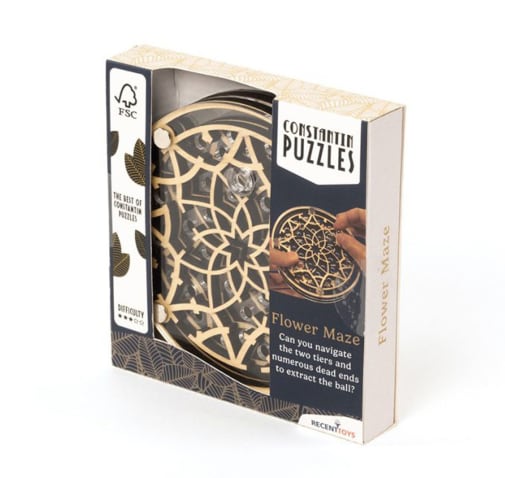This wooden circular maze puzzle is two-tiered and features a flower design. The goal? Try to get the little ball out of the maze by tipping and flipping the puzzle to send the ball down different pathways. But with numerous dead ends and two levels, it might not be as easy as it seems! If you succeed and want to play again, simply push the ball through the little “c”-shaped hole. With a 4.5/5 difficulty level, this is recommended for ages 14+, but younger kids would probably be just as enthralled with the puzzle even if it takes them longer to complete.
Flower Maze Puzzle (Constantin Collection)
SKU
042897
Grade 9-AD
These icons are designed to help you quickly understand and learn important information about our products.
Teaching Method
Traditional
Teacher-centered curriculum commonly used in classrooms that may include a text, teacher manual, tests, etc.
Charlotte Mason
A methodology based on the work of a 19th century educator who maintained that children learn best from literature (Living Books), not textbooks.
Classical
A methodology based on the Latin Trivium (three stages of learning), including the grammar stage (memorization and facts), logic stage (critical thinking), and rhetoric stage (developing/defending ideas).
Unit Study
A thematic or topical approach centered around one topic that integrates multiple subject areas.
Montessori (Discovery)
A methodology based on the work of a 20th century educator that emphasizes student and sensory-driven discovery learning and real-life applications.
Other
Other methodologies
Religious Content
Secular
Contains content contrary to common Christian beliefs (i.e. evolution).
Neutral
Avoids religious or theoretical topics or presents multiple viewpoints without preference.
Christian/Religious
Faith-based or including instructional religious content.
Learning Modality
Auditory
Learns through listening, talking out loud or reading out loud.
Visual
Learns through seeing, prefers written instructions and visual materials.
Kinesthetic/Tactile (Hands-On)
Learns through moving, doing and touching.
Multi-Sensory
Curriculum that employ a variety of activities/components.
Presentation
Sequential
Curriculum progresses through well-defined learning objectives. Emphasizes mastery before moving to the next topic.
Spiral
Topics and concepts are repeated from level to level, adding more depth at each pass and connecting with review.
Conceptual/Topical
Focus is on the “why,” often with a unifying concept as well as specific skills; coverage may be broader.
Teacher Involvement
Low Teacher Involvement
Student-led materials; parent acts as a facilitator.
Medium Teacher Involvement
A mix of teacher-led time and independent student work.
High Teacher Involvement
Teacher-led lessons; may utilize discussions, hands-on activities and working together.
Additional Materials Required
No other materials needed
Everything you need is included.
Other Materials Required
There are additional required resources that are a separate purchase.
Other Materials Optional
There are additional resources mentioned or recommended but are not absolutely necessary.
Consumable
Consumable
Designed to be written in; not reusable.
Non-Consumable
Not designed to be written in; reusable.
Our Price
$24.99 Product Overview
- Try to get the ball out of the maze by tipping and turning the wooden flower puzzle!
- The maze is two-tiered and has numerous dead ends, so it might be harder than you think
- 4.5/5 difficulty level
- Recommended for ages 14+ but could be enjoyed by younger kids too
Description
Publisher's Description of Flower Maze Puzzle (Constantin Collection)
Can you buzz along the flower’s petals, turn and flip the puzzle to move the ball of ‘pollen’ between two layers and finally extract the pollen? If you can solve it, success will smell sweet, indeed!
Category Description for Constantin Collection Puzzles
These unique puzzles are intricately built and designed, and each puzzle features different shapes and elements to create different types of challenges. The Flower Maze poses a goal of navigating two tiers to extract a ball within; for the Ship in the Bottle puzzle, assemble the puzzle within the “bottle”; and lastly, the Tough Measures puzzle presents two rulers to be perfectly positioned to fit on a grid.
Details
| Product Format: | Other |
|---|---|
| Grades: | 9-AD |
| Brand: | Smart Games |
| EAN/UPC: | 847563002542 |
| Length in Inches: | 5.75 |
| Width in Inches: | 5.375 |
| Height in Inches: | 1 |
| Weight in Pounds: | 0.5 |
Videos
Reviews

